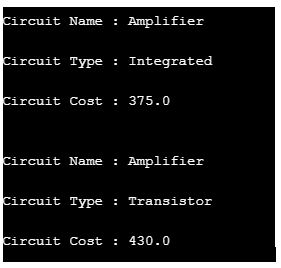중첩 클래스는 다른 클래스 내부에 있는 클래스를 의미합니다. Java를 사용하면 Java에서 중첩 클래스를 만들 수 있습니다. 중첩 클래스는 외부 클래스의 멤버 중 하나입니다. 공개, 비공개, 보호 또는 기본값으로 선언할 수도 있습니다. 중첩 클래스는 외부 클래스의 다른 멤버에 액세스할 수 있지만 그 반대의 경우는 불가능합니다. 이는 중첩 클래스가 자신을 둘러싸는 외부 클래스의 멤버이므로 외부 클래스가 중첩 클래스 멤버에 액세스할 수 없음을 의미합니다. 따라서 점(.)을 사용하여 중첩 클래스 및 해당 멤버에 액세스합니다. 중첩 클래스에는 정적 키워드가 없습니다.
무료 소프트웨어 개발 과정 시작
웹 개발, 프로그래밍 언어, 소프트웨어 테스팅 등
Java의 중첩 클래스 범주
중첩 클래스는 두 가지 범주로 나뉩니다.
-
정적 중첩 클래스: "정적"이라는 키워드로 선언된 중첩 클래스를 정적 중첩 클래스라고 합니다. 정적 중첩 클래스는 외부 클래스를 참조하여 액세스할 수 있습니다. 정적 클래스가 있는 중첩 클래스는 외부 클래스의 비정적 변수 및 메서드에 액세스할 수 없습니다.
-
내부 클래스: 비정적 중첩 클래스는 정적으로 선언되지 않은 내부 클래스입니다. 비공개로 선언된 경우에도 정적 중첩 클래스는 모든 정적 및 비정적 변수 및 메서드에 액세스할 수 없습니다. 내부 클래스도 2가지 종류가 있습니다.
구문:
아래 구문에서 OuterClass에는 Nested 클래스로 알려진 InnerClass 내부 클래스가 있습니다.
1 2 3 4 5 6 7 | class OuterClass {
class InnerClass {
....
}
}
|
로그인 후 복사
Java에서 중첩 클래스 사용
프로그래밍 세계에서 Nested 클래스는 아래와 같이 중요한 역할을 합니다.
- 클래스 중첩은 다른 클래스 범위의 클래스를 그룹화하는 것과 같습니다. 다른 곳에서는 중첩 클래스를 사용할 수 없습니다.
-
가독성 및 유지 관리 용이성: 클래스 중첩은 코드 가독성을 높이고 다른 클래스에 영향을 주지 않으므로 유지 관리가 더 쉽습니다.
-
코드 감소: 중첩 클래스를 사용하면 코드 줄이 줄어들어 최적화가 가능합니다.
-
캡슐화 증가: 중첩 클래스에서 내부 클래스는 바깥쪽 클래스의 멤버에 액세스할 수 있습니다. 동시에 외부 클래스는 내부 클래스 멤버에 직접 액세스할 수 없습니다. 또한 내부 클래스는 외부 프로그램에서 표시되거나 액세스할 수 없습니다.
Java의 중첩 클래스 예
아래는 Java의 중첩 클래스 예입니다.
예시 #1
이 예에서는 외부 클래스를 참조하여 내부 클래스의 인스턴스화를 관찰할 수 있습니다.
코드:
1 2 3 4 5 6 7 8 9 10 11 12 13 14 15 16 17 18 19 | class Engine{
static double fuel = 20.0;
static class Ignition{
void showFuelSpend() {
System.out.println("Fuel Spend = " + fuel + " Ltrs");
}
}
}
public class NestedClassExample{
public static void main(String[] args) {
Engine.Ignition engIgnitObj = new Engine.Ignition();
engIgnitObj.showFuelSpend();
}
<u>}</u>
|
로그인 후 복사
출력:

예시 #2
이 예에서는 내부 클래스를 인스턴스화하는 방법을 볼 수 있습니다. 내부 클래스의 인스턴스를 생성하려면 내부 클래스의 인스턴스가 필요합니다. Outer 클래스의 인스턴스를 생성한 후 그 안에 중첩 클래스의 인스턴스를 생성하는 것이 가능해집니다.
코드:
1 2 3 4 5 6 7 8 9 10 11 12 13 14 15 16 17 18 19 20 21 22 23 24 25 26 27 28 29 30 31 | class Volume{
double x, y, z;
Volume(double x, double y, double z) {
this.x = x;
this.y = y;
this.z = z;
}
class Measurement{
void totalArea(double i, double j) {
System.out.println("\nArea for the provided container is " + (i * j));
}
void totalVolume(double i, double j, double k) {
System.out.println("\nVolume for the provided container is " + (i * j * k));
}
}
}
public class NestedClassCalcExample {
public static void main(String[] args) {
Volume volObj = new Volume(30.0, 25, 18.0);
Volume.Measurement volMeasureObj = volObj.new Measurement();
volMeasureObj.totalArea(volObj.x, volObj.y);
volMeasureObj.totalVolume(volObj.x, volObj.y, volObj.z);
}
}
|
로그인 후 복사
출력:

예시 #3
이 예는 외부 클래스의 인스턴스 내에서 중첩 클래스 객체의 인스턴스화가 어떻게 발생하는지 보여줍니다.
코드:
1 2 3 4 5 6 7 8 9 10 11 12 13 14 15 16 17 18 19 20 21 22 23 24 25 26 27 28 29 30 31 32 33 34 35 36 37 38 39 40 41 42 43 44 45 46 47 48 | class Electronic{
String circuitName,
String circuitType;
double circuitCost;
Electronic(String name, String type, double cost) {
this.circuitName = name;
this.circuitType = type;
this.circuitCost = cost;
}
String getCircuitName() {
return this.circuitName;
}
class Circuit{
String circuitType;
double circuitCost;
void setCircuitType() {
this.circuitType = "Transistor";
this.circuitCost = 430.0;
}
String getCircuitType(){
return this.circuitType;
}
double getCircuitCost(){
return this.circuitCost;
}
}
}
public class Product{
public static void main(String[] args) {
Electronic elObj = new Electronic("Amplifier", "Integrated", 375.0);
Electronic.Circuit circuit = elObj.new Circuit();
System.out.println("\nCircuit Name : " + elObj.circuitName);
System.out.println("\nCircuit Type : " + elObj.circuitType);
System.out.println("\nCircuit Cost : " + elObj.circuitCost);
circuit.setCircuitType();
System.out.println("\n\nCircuit Name : " + elObj.getCircuitName());
System.out.println("\nCircuit Type : " + circuit.getCircuitType());
System.out.println("\nCircuit Cost : " + circuit.getCircuitCost());
}
}
|
로그인 후 복사
출력:

결론
위 기사에서는 Java에서 Nested 클래스가 어떻게 필수적인지 검토했습니다. 클래스 중첩을 활용하는 것이 좋습니다. 위 글에서는 Nested 클래스의 유용성에 대해서도 설명하고 있습니다.
위 내용은 Java의 중첩 클래스의 상세 내용입니다. 자세한 내용은 PHP 중국어 웹사이트의 기타 관련 기사를 참조하세요!


